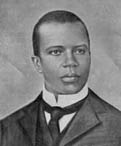

The club was run by Walker and Will Williams, and located on the second floor of 121 East Main, just over a block east of the primary downtown route, Ohio Street. It was while working in one of the many drinking and gathering establishments in Sedalia in the summer of 1899, the short-lived (December 1898 to January 1900) Maple Leaf Club, that Scott allegedly became involved with one of his greatest champions, music store owner John Stark, and at the very least where he found the name for his first truly inspired rag. Scott's next move towards greatness was back in Sedalia. There have also been stories that Joplin submitted another fine rag to Daniels but that it was rejected as too difficult, but again such stories are hard to confirm, even if they are plausible. There is no clear evidence, based on Daniel's work or his later recollections, that Charles arranged anything more than to have it published. Daniels, who received an "arranged by" credit on the cover. It was endorsed by Hoffman's young staff composer and whiz kid Charles N. He had submitted a work to Kansas City, Missouri publisher Carl Hoffman. Scott's first piano rag publication came in early 1899.

Whether the piece was perhaps commissioned by the publisher or was just opportunism is unknown. While it has few descriptive titles in it, there is detailed text denoting the passage with the fatal wreck of the trains speeding towards each other at 60 miles per hour. Joplin's march was published soon afterwards in Temple, Texas. With around 40,000 spectators in attendance to watch the spectacle, it was inevitable that at least two would be killed by the boiler explosion following the crash. That afternoon did not go quite as planned. In reality, it was composed to commemorate a wreck staged by agent William George Crush of the Missouri-Kansas-Texas (Katy) railroad line in Texas on September 15, 1896. Paull, who was already gaining fame for his Chariot Race or Ben Hur March, Joplin's The Great Crush Collision was intended to emulate a leisurely afternoon journey ending in a horrific train wreck. A descriptive piece in a style that would soon be the domain of composer E.T.

His first instrumental works included two typical waltzes of the period, and one ambitious march.


 0 kommentar(er)
0 kommentar(er)
